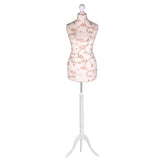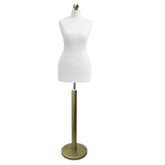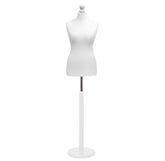A Guide to Plastic Stacking Storage Boxes
Feeling overwhelmed by clutter is a common battle. The real secret to winning isn't necessarily about owning less, but about organising what you have more intelligently. This is where plastic stacking storage boxes come into play. They’re the key to turning unused vertical space into a highly efficient, streamlined system that brings order to any room.
The Secret to Modern Home Organisation
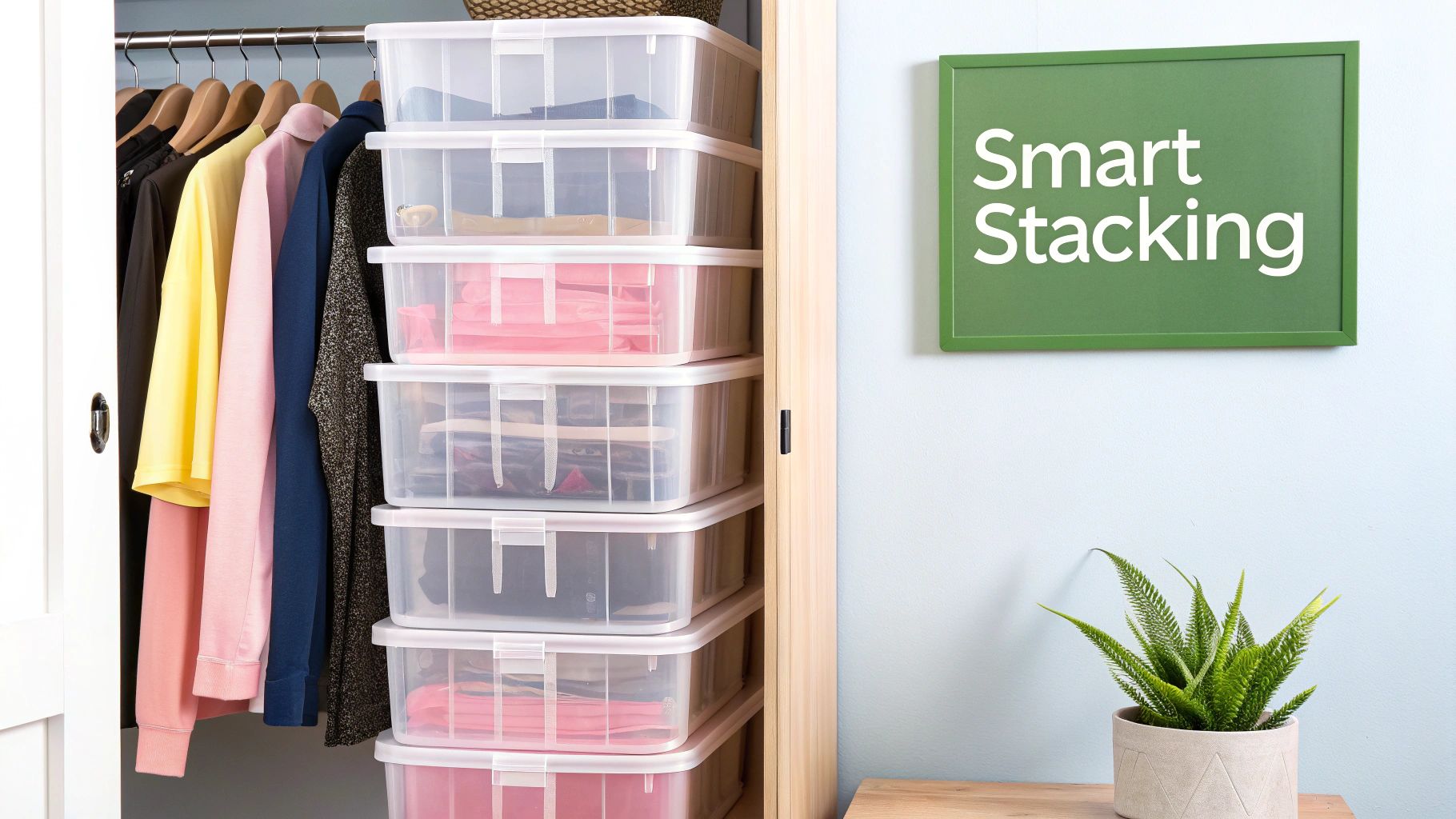
At its heart, a well-organised home, office, or workshop isn't just about being tidy—it's about creating systems that are functional and easy to access. Plastic stacking boxes are the literal building blocks for these systems, letting you finally get a handle on clutter and take back precious floor space.
The principles are universal, whether you're trying to organise a cramped wardrobe in a small UK flat or manage stock in a busy warehouse. This move towards structured, thoughtful living isn't just a fleeting trend. The global market for storage boxes is on a steady rise, fuelled by a wave of home improvement projects and the simple, universal need for better storage.
Why Stacking Is a Game Changer
Vertical space is often the most overlooked asset in any room. By stacking boxes, you can build your storage upwards, effectively multiplying your capacity without eating into your floor plan. It's like building a skyscraper on a small plot of land; you're making the most of what you have by going vertical. To truly get your space in order, it pays to explore diverse storage solutions that fit different needs.
This guide will walk you through everything you need to know, from choosing the right boxes to using and maintaining them for years to come.
A great storage system gives you something invaluable: your time back. When everything has its place, you stop wasting energy searching and start spending more time on what you love.
A Foundation for Any Project
These boxes are a game-changer for everyone, from hobbyists to professionals. For example, our guide on sewing room organisation shows just how much difference a structured storage setup can make in a creative space where every little piece matters.
Understanding Your Storage Box Materials and Design
It’s easy to walk down an aisle of plastic storage boxes and assume they’re all pretty much the same. But the truth is, the type of plastic and the specific design details are what separate a box that lasts a lifetime from one that cracks under the first sign of pressure. Getting to grips with these differences is the secret to investing in a truly dependable organisation system.
You see, not all plastics are created equal. In the world of storage boxes, you'll mainly come across two contenders: Polypropylene (PP) and Polyethylene (PE). Think of them like different types of wood; you wouldn't build a garden shed and a kitchen cabinet from the same material, and the same logic applies here.
The Tale of Two Plastics: Polypropylene vs. Polyethylene
Polypropylene (PP) is the workhorse of the two. Imagine it as the strong, rigid spine of a hardcover book. It’s a tough material known for its stiffness and excellent resistance to heat and chemicals. This rigidity is precisely what allows PP boxes to be stacked high without buckling, making them perfect for heavier loads like tools, books, or dense archive files.
On the other hand, Polyethylene (PE) is more like a durable, flexible chopping board. It can take a knock without shattering and is far more forgiving in cold temperatures where other plastics can go brittle. This makes PE boxes a fantastic choice for places with fluctuating temperatures like a garage, loft, or shed, or for storing things that might get jostled about.
- Polypropylene (PP): Your go-to for heavy, static loads and stable stacking in temperature-controlled rooms.
- Polyethylene (PE): The champion of durability and impact resistance, especially in unheated spaces like garages or sheds.
A quick glance at the recycling symbol on the bottom of the box (usually a #5 for PP and a #2 or #4 for PE) will tell you exactly what you’re dealing with. Matching the material to the job is the first step in building a storage solution that won't let you down.
The Anatomy of a High-Quality Storage Box
Beyond the plastic itself, the actual engineering of the box is what truly determines its performance. A well-designed container isn't just a simple vessel; it’s a thoughtfully constructed piece of equipment.
One of the most important things to look for is reinforced corners and ribs. These act just like the pillars and beams in a building, channelling weight down through the structure and preventing the sides from bowing or collapsing when stacked. A box with a flimsy, flat base and weak corners is a disaster waiting to happen.
A great storage box is designed with physics in mind. Its strength comes not just from the material, but from how that material is shaped to channel force and resist pressure, ensuring stability and longevity.
Another make-or-break feature is the interlocking lid design. A good lid doesn't just sit loosely on top. It will have deep grooves or channels that securely lock into the base of the box stacked above it. This is what stops the stack from shifting and creates a solid, stable tower that won't come tumbling down.
Finally, don't overlook the handles. Ergonomic, reinforced handles make a world of difference when you're lugging a heavy box around. Thin handles that dig into your hands or, even worse, snap off completely are a hallmark of a cheap, poorly made product. Quality boxes have handles moulded right into the main structure for maximum strength.
For those setting up a dedicated workspace, choosing the right containers is just one part of the equation. You can dive deeper into creating an efficient setup by exploring our ideas for storage units for crafts, which shows how the right kind of storage can completely transform your workflow.
How to Choose the Right Plastic Storage Boxes
https://www.youtube.com/embed/YYliRJHZiGE
Picking the right plastic storage box isn't just about grabbing the first one you see. It's about making a smart choice that actually solves your clutter problem. If you take a moment to figure out exactly what you need, you can create an organisation system that genuinely makes your space feel more orderly and efficient.
Think of it like this: you wouldn’t use a tiny screwdriver on a massive screw. In the same way, the flimsy box that's perfect for old baby clothes won't cut it for a collection of heavy hardback books. The first step is always to take stock of what you actually need to store.
Assess Your Size and Capacity Needs
Getting the size right is probably the most important part of the puzzle. Are you carefully putting away small, sentimental items like old photos, or are you trying to wrestle a king-sized duvet into submission? Using the wrong size box is a recipe for frustration.
A box that’s far too big for its contents is just wasted space, and your things will slide around inside. On the flip side, overstuffing a box that’s too small will make the lid bulge, meaning it won’t stack properly and could even break.
- Small Boxes (5-20 Litres): These are your best friends for corralling all those little things that seem to disappear. Think craft supplies, spare cables, and all that office stationery.
- Medium Boxes (20-50 Litres): The classic all-rounder. They’re brilliant for clothes, kids' toys, important documents, or extra kitchen bits and bobs.
- Large Boxes (50+ Litres): Perfect for things that are bulky but not too heavy. We’re talking about bedding, Christmas decorations, or sports gear. A word of warning: avoid filling these with heavy items like books, as they’ll be a nightmare to lift.
Before you even think about buying, get out the tape measure. Know the dimensions of your shelves, the space under your bed, or the corner of the garage where the boxes will live. It’ll save you the headache of returning containers that just don’t fit.
Consider Lid Types for Access and Protection
The lid isn't just an afterthought; it’s a key feature that dictates how easy your boxes are to use and how well they protect what's inside. You'll mainly find two types: clip-on and hinged.
Clip-on lids come off completely, giving you wide-open access to everything inside. This is fantastic when you’re packing or unpacking a whole box at once, like switching out seasonal clothes or filing away paperwork. The clips also tend to create a much tighter seal, which is a big plus for keeping out dust and damp.
Hinged lids, on the other hand, stay attached. This is a game-changer for things you dip into often, because you can’t lose the lid! They’re a great shout for a child’s toy box or for storing tools you need to grab in a hurry.
The right lid design should make your life easier. For long-term storage, go for clip-on. For anything you access regularly, a hinged lid is the way to go.
Clear vs. Opaque Boxes: A Strategic Choice
Deciding between clear and opaque boxes comes down to a simple trade-off: do you want to see what’s inside, or do you want a clean, minimalist look?
Clear boxes let you identify the contents at a glance. This is a massive time-saver, especially in places like a craft room, pantry, or playroom where you need to find something specific, fast. For tiny items like beads or buttons, our guide on choosing a sewing organiser box offers some extra-specialised tips.
Opaque boxes are all about creating a calm, uncluttered visual. They're the perfect choice for storage that’s on show—like open shelving in a living room or office—where a jumble of different items would just look messy. If you go this route, just make sure you have a solid labelling system in place!
This infographic can help you visualise which type of box might be best for your needs.
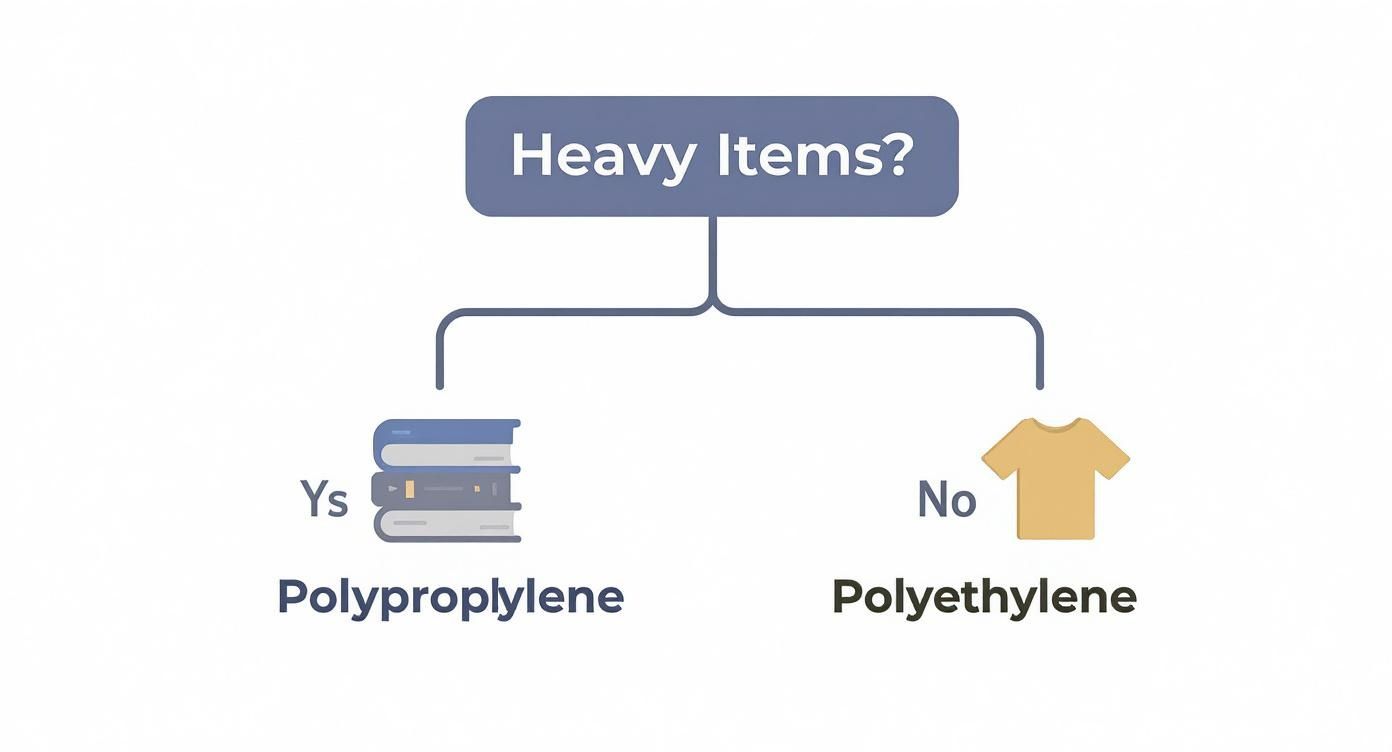
As you can see, it’s all about matching the material to the job. Sturdy Polypropylene is great for your heavier stuff, while the more flexible Polyethylene is better suited to lighter goods.
Thinking ahead like this is becoming more common across the entire industry. Here in the UK, the rigid plastic packaging market is expected to hit 3.28 million metric tons by 2025. Big manufacturers are also putting a greater focus on sustainability, with a real push towards using more recycled materials—a trend that will only continue to grow.
Mastering Your Space with Stacking Strategies
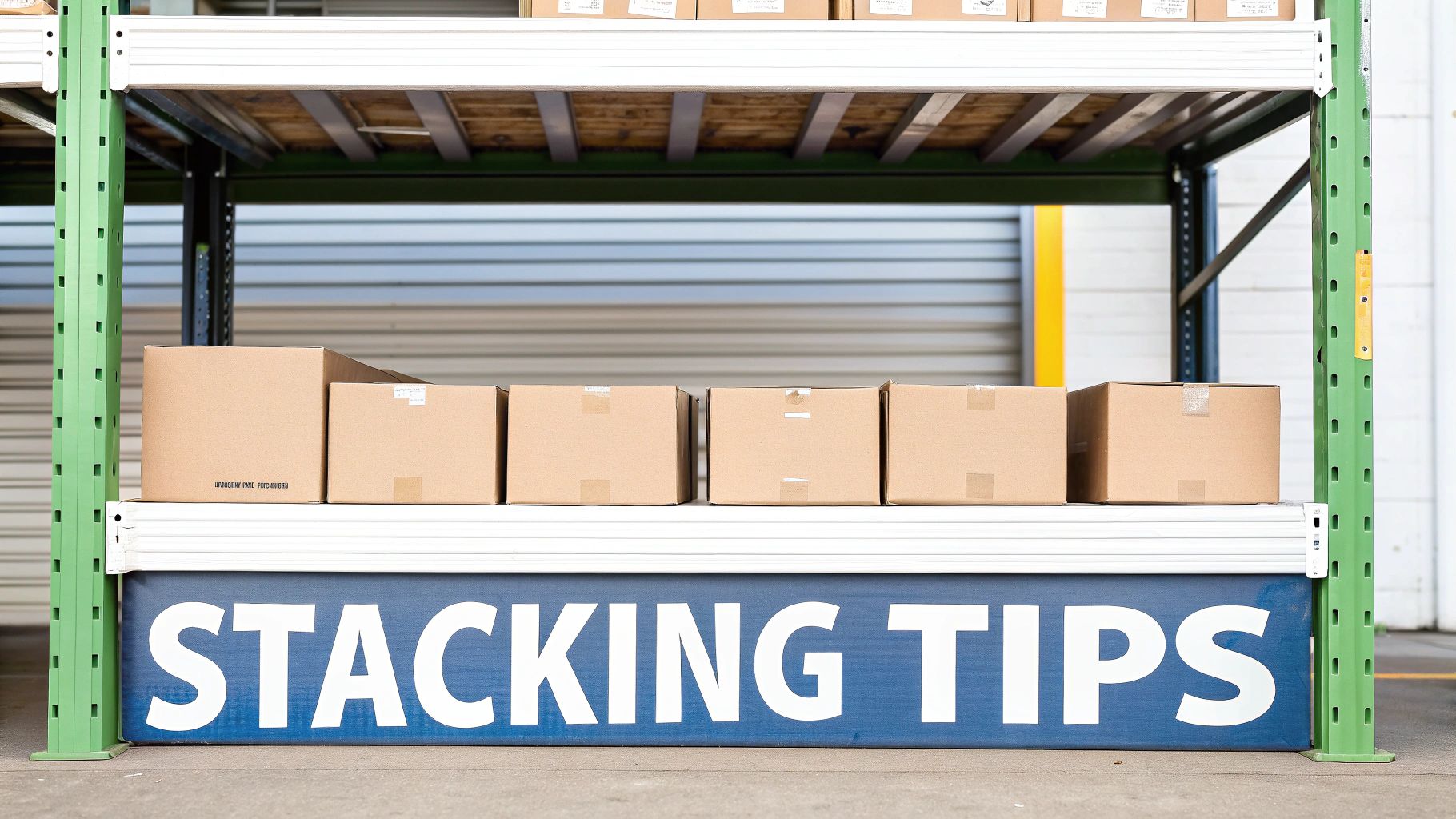
Simply owning a set of high-quality plastic stacking storage boxes is just the beginning. The real magic happens when you put them to work with a smart strategy. Effective stacking is far more than just piling boxes on top of each other; it's about creating a stable, accessible, and incredibly efficient system that makes the most of every inch of vertical space.
Think of it like organising a library. A room with books just thrown onto shelves is chaotic and pretty much useless. But a well-organised library, with a clear system, makes finding what you need a breeze. The very same principle applies to your storage boxes.
Building a Foundation of Stability
The first, and most important, rule of stacking is to build from the ground up with stability as your top priority. This all starts with weight distribution—a simple concept that keeps your stacks safe and secure.
Always, always place your heaviest boxes at the very bottom. This creates a low centre of gravity, which makes the entire column far less likely to wobble or topple over. Stacking a box of heavy books on top of a box of soft toys is just asking for trouble.
It’s also crucial to distribute the weight evenly inside each box. Put heavier items in the centre and at the bottom, then fill the gaps and the top layer with lighter things. This stops the box from becoming lopsided and causing the whole stack to lean.
A stable stack is a safe stack. By mastering weight distribution, you’re not just organising; you’re creating a secure structure that protects both your belongings and yourself from accidents.
Creating an Accessible System
Let’s be honest, a storage system is only useful if you can actually find things. If you have to unstack ten boxes just to get to one item, the system has failed. Accessibility needs to be at the heart of your strategy right from the start.
Here are a few practical tips to make sure you can always find what you need:
- Prioritise with Transparency: Use clear boxes for things you access often. Being able to see the contents of your most-used boxes—like craft supplies or the kids' toys—cuts out the guesswork and saves a surprising amount of time.
- Zone Your Storage: Group similar items together. Set aside specific stacks or shelf sections for different categories, such as 'Christmas Decorations', 'Archived Paperwork', or 'Camping Gear'.
- Avoid the "Last In, First Out" Trap: Don’t bury seasonal items. The box of winter coats shouldn't be stuck behind the summer beach gear. Think about when you'll need things next and plan your stacks accordingly.
Of course, how you pack the boxes is just as important as how you stack them. Once you’ve got your containers sorted, learning how to stow your belongings in packing boxes efficiently will help you make the most of every last bit of space.
The Power of a Simple Label
For opaque boxes or anything you’re putting into long-term storage, a clear and consistent labelling system is non-negotiable. Don't fall into the trap of scribbling a vague word like "Stuff" on a bit of tape. You need to be specific and methodical.
- Be Descriptive: Instead of "Kitchen," write "Spare Crockery & Glassware." Rather than "Photos," try "Family Holidays 2010-2015."
- Face Labels Outwards: This sounds obvious, but you’d be surprised how often it's overlooked. Make sure every label is clearly visible without you having to move the box.
- Create a Master List: For really complex storage areas, like a loft or garage full of boxes, think about making a simple spreadsheet. Number each box and list its main contents on your digital list for a quick search.
Combining these strategies will turn a humble collection of containers into a powerful organisation machine. For those looking to take it a step further and maximise wall space, options like a wall-mounted hanging rail can perfectly complement your box system, creating a complete solution that tackles clutter from every angle.
Rethinking the Plastic Box: Sustainability and Smart Design
The simple plastic storage box is getting a serious upgrade. Gone are the days when it was just a functional, often clunky, container. Today, as we all become more conscious of our environmental impact, the industry is responding with smarter, more sustainable designs. This isn't just about making a better box; it's about reinventing storage for the modern home.
One of the biggest moves is towards using recycled materials. Manufacturers are embracing a circular approach, taking old plastics that would otherwise end up in a landfill and transforming them into sturdy, reliable plastic stacking storage boxes. This simple change has a huge effect, cutting down on the need for new plastic, reducing waste, and lessening the carbon footprint of production.
A Push from All Sides
This green wave isn't happening in a vacuum. It’s being driven by a powerful combination of government policy and what you, the customer, want to see on the shelves. In the UK, for instance, the Plastics Packaging Tax is a game-changer. It puts real financial pressure on companies to include at least 30% recycled plastic in their products, pushing innovation forward.
At the same time, people are voting with their wallets. The UK’s plastic packaging market is already massive—valued at around USD 22.71 billion for 2025—and it’s expected to climb to nearly USD 26 billion by 2030. In a market that big, sustainability has become a key selling point, not just a box-ticking exercise. You can dig deeper into these market trends and projections on Mordor Intelligence.
The future of storage is circular. By choosing boxes made from recycled materials, you’re not just organising your home; you’re supporting a more sustainable way of making things, one that respects our resources and aims for zero waste.
This shift puts the power back in your hands, allowing you to find high-quality storage that also aligns with your values.
More Than Just a Box: Smart Design Takes Centre Stage
It's not all about the material, though. The design of plastic stacking storage boxes is evolving to be far more intelligent and user-friendly. The old-school, purely functional look is being replaced by designs that look good and work even better.
Here’s what’s new on the design front:
- Modular Systems: Think of them like Lego for your storage. Instead of settling for a few standard sizes, modular systems offer interlocking boxes that you can mix and match. This lets you create a truly custom setup that fits your space perfectly.
- Looks That Matter: Storage is coming out of the shadows. With sleek finishes, a wider palette of colours, and clean, minimalist lines, these boxes are designed to be seen. They fit right in on open shelves in a living room or a stylish home office.
- Clever Little Details: It's the small things that often make the biggest difference. We're seeing more boxes with built-in label holders, clear viewing windows so you can see what’s inside, and clever dual-hinged lids that let you grab something without having to unstack the whole tower.
All these changes point to a new era for storage. The plastic stacking box is no longer just a container; it’s a well-designed product that’s practical, stylish, and kinder to the planet.
Caring for Your Storage Boxes for Lasting Use
You've invested in a good set of plastic stacking storage boxes, which is a great first step. Now, let's make sure they last. With a bit of straightforward care, you can keep them in top condition for years, which is better for your wallet and the planet.
A little maintenance goes a long way. It protects your investment and ensures your boxes stay reliable. These simple habits can stop common problems like cracked plastic, stubborn stains, and other minor damage before they even start.
Routine Cleaning and Maintenance
Keeping your boxes clean is the absolute foundation of good care. Before you pack anything away, especially clothes or important papers, give the inside a quick wipe with a damp cloth and a touch of mild soap. This gets rid of any dust or residue from the factory.
For a deeper clean, warm water and a bit of washing-up liquid will do the trick. Steer clear of abrasive pads or harsh chemical cleaners like bleach. They can scratch the surface and weaken the plastic over time. A soft cloth is always your best bet.
Think of your storage boxes like any other tool in your home. A little maintenance goes a long way. Keeping them clean and storing them correctly ensures they're always ready and reliable when you need them.
After washing, make sure the box is completely dry before you pop the lid back on. Any trapped moisture can lead to mildew, which will ruin whatever's inside and leave a nasty smell that’s a real pain to get rid of.
Tackling Common Issues
Even the best-cared-for boxes can run into a few snags. Here’s how to handle them.
- Sticky Label Residue: We've all been there. That gummy mess left behind by old labels. To shift it, dab a bit of vegetable oil or a proper sticky stuff remover onto a cloth and gently rub the area. The residue should come away easily without scratching the plastic.
- Minor Cracks: If a box gets a small crack that doesn't affect its structure, you can often repair it. A strong, waterproof plastic glue or even some heavy-duty duct tape on both sides can stop it from spreading. This is a great fix for boxes holding lighter items.
- Sun Damage Prevention: Direct sunlight is plastic's worst enemy. UV rays will make it brittle and discoloured over time. To avoid this, always try to store your plastic stacking storage boxes somewhere cool, dark, and dry. A cupboard, the loft, or a garage are all perfect spots, as long as they're out of the sun.
Following these simple tips will help you get years of use out of your storage system. This is especially true for more specialised containers, as you can see in our guide on the best ways to use a sewing organiser box for all your delicate craft supplies.
Got Questions About Storage Boxes? We've Got Answers
Even the most seasoned organiser runs into a few head-scratchers now and then. When you're deep in a project, questions always seem to come up. So, I've put together answers to some of the most common queries I hear about plastic stacking storage boxes.
Think of this as your go-to guide for troubleshooting common issues and getting the absolute most out of your new storage system.
Can I Stack Boxes From Different Brands?
In a word, no. It's a tempting shortcut, especially if you have a few odd boxes lying around, but it's one I strongly advise against. The locking systems—the grooves on the lids and the corresponding indents on the base—are unique to each manufacturer.
Trying to stack a box from one brand on top of another is like trying to fit a square peg in a round hole. It simply won't lock securely. You'll end up with a wobbly, unstable tower that's just an accident waiting to happen. For a truly secure and stable stack, always stick to the same brand and product line.
How High Can I Safely Stack My Boxes?
This is a classic "it depends" situation. There's no single magic number, as the safe height is a careful balance of a few different things: the box itself, what's inside it, and where you're putting it.
- The Weight Inside: Always start with your heaviest boxes at the bottom. This creates a solid foundation. Lighter boxes can go on top, but a stack full of heavy books can't go as high as one filled with soft toys.
- The Quality of the Box: A well-made box with reinforced corners and a strong lid is built to handle more vertical weight. Cheaper, more flexible boxes will start to buckle much sooner.
- The Surface It's On: A flat, level concrete floor is the ideal stage. If you're stacking on plush carpet or an uneven surface, you're introducing instability right from the start.
My rule of thumb is simple: never stack them so high that they feel wobbly or become difficult to access safely. A secure, shoulder-height stack is far more practical than a teetering tower.
Remember, safety always trumps squeezing in one more box. A stable stack is an effective stack. A collapsed one is a dangerous mess.
Are Plastic Stacking Storage Boxes Waterproof?
This is a common misconception. Most standard plastic boxes are water-resistant, but they are not fully waterproof. A quality box with a good lid and secure clips will do a fantastic job of keeping out dust, moisture, and the odd splash.
However, if you submerged one in water, it would eventually leak. For basements or areas prone to flooding, you need to either get your stacks up off the floor on shelving or look for specialised waterproof containers that have a rubber gasket seal. For most lofts, garages, or wardrobes, a standard box offers all the protection you'll need from dampness in the air.
At Display Guru, we're passionate about providing professionals and hobbyists with the tools to create spaces that are both functional and inspiring. To see how our garment rails and other storage solutions can complete your setup, take a look at our full collection at https://www.displayguru.co.uk.


